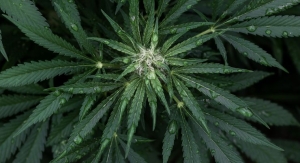By Dilip Ghosh, PhD, FACN, nutriConnect09.10.18
The cannabis plant, which may be different species (principally Cannabis sativa and Cannabis indica) or variants of the same species, is a dioecious entity and contains a number of unique resorcinol metabolites—estimates vary from 60-110. The most recognizable cannabinoid metabolite is delta-9-tetrahydrocannabinol (THC). Recent published data described the pharmacology of two other agents, cannabidiol (CBD) and delta-9-tetrahydrocannabivarin (THCV), and concluded that these compounds exhibited complex interactions with the human endocannabinoid system. Apart from these three compounds, other cannabinoids that have shown pharmacological effects include cannabigerol, cannabidivarin, cannabidiolic acid, and cannabichromene.
Evidence of cannabis use for medical purposes can be traced back to 2737 BCE in ancient China. Since then there have been wide variations in the use and acceptance of cannabis as a drug therapy in Western medicine. In 1999, California was the only U.S. state that allowed patients to access cannabis for medicinal purposes. By 2016, there were 24 states where cannabis was available as a therapeutic agent, and three that had approved cannabis for recreational use.
The Cannabis Plant
Cannabis is one of the most complicated and challenging plants to taxonomists and arboriculturists. Cannabis is predominantly dioecious, with male and female flowers by definition developing on separate plants if grown naturally from seed. However, occasionally, it exhibits a monoecious (hermaphrodite) nature. Cannabis is normally a so-called “short-day plant.” At the end of summer, when the plants detect an increase in night length, they commence flowering. But after decades of research, scientists are now able to develop “auto flowering” cannabis plants, which aren’t as day-length sensitive, and start flowering when they are only about 2 weeks old. For the production of cannabinoids, all-female crops are preferred, because male plants produce much lower quantities of cannabinoids. The cannabinoids are predominantly, if not entirely, synthesized and sequestered in small structures called glandular trichomes and this tissue is the female flower.
Terminology & Usage
Raw herbal (botanical) cannabis is any part of any plant of the genus Cannabis. The genus Cannabis belongs to the Cannabaceae family. Some people believe cannabis is a single species, with C. indica, C. sativa, and C. ruderalis as three different subspecies, while others consider them three different species of Cannabis.
Plants grown for fiber and seed are commonly referred to as hemp, whereas cannabis extract refers to any preparation that is removed from the plant, usually by organic solvents to produce oil.
Cannabinoids are a class of chemical compounds that have the typical cannabinoid skeleton in common and affect the cannabinoid receptors. Other than naturally occurring cannabinoids, a few synthetic cannabinoids are manufactured today as approved drugs (cannabinoid-based medicines).
Common Usage. The hemp plant has been used across the globe for centuries in the production of rope, sail, cloth, and paper. There is strong anecdotal evidence of medicinal use of hemp from ancient China, India, and Egypt for centuries.
The term “cannabis abuse” is a relatively recent viewpoint. In the 1970s, cannabis extract was widely availabile in Europe and North America as a “recreational drug.” The leaves (variously referred to as marijuana or herbal cannabis, among many other names) or resin derived mostly from the buds (known as hashish, or many other names) are typically smoked. Smoking involves measures of volatilization and pyrolysis, and results in a relatively poor delivery of metabolites.
Therapeutic/Medicinal Use. Currently, there are a few cannabinoid-based medicines available for marketing in different countries: Nabiximols (Sativex)—oromucosal spray formulated from extracts of the C. sativa plant that contains the cannabinoids THC and CBD; Nabilone (Cesamet or Canemes)—oral capsules containing a synthetic cannabinoid similar to THC; Dronabinol (Marinol or Syndros)—oral capsules or an oral solution containing synthetic delta-9-THC. The U.S. FDA also recently approved Epidiolex (cannabidiol), an oral solution for the treatment of seizures associated with two rare and severe forms of epilepsy.
Nutraceutical/Lifestyle/Cosmetic Use. More peripheral cannabis products such as cosmetics, food/dietary supplements, edibles, oils, and recreational-use products, as well as fiber and biofuel applications may offer more return on investment than medicinal drugs, given the shorter path to market.
Functional beverages containing cannabis are noteworthy and offer a unique delivery mechanism. At Vitafoods Europe 2018, Donny Mistarz, CSO and co-founder of Plantine Holdings Limited, noted that his company “can produce a fully neutral and water-soluble product with increased bioavailability, giving the formulators full control over the taste experience of their final products.” Plantine is a large vertically integrated producer, manufacturer, and distributor of hemp products.
Chemistry of Cannabis
Cannabis contains many unique resorcinol metabolites, but the exact number is still debatable. The best estimate is around 60-110. The most recognizable cannabinoid is delta-9-tetrahydrocannabinol (THC). Many recent studies identified and described the pharmacology of three of these agents—cannabidiol (CBD), delta-9-tetrahydrocannabivarin (THCV), cannabigerol (CBG)—and concluded that these compounds exhibited complex interactions with the endocannabinoid system.
In fresh plant material, these cannabinoids all exist in the cannabinoid acid forms, such as delta-9–tetrahydrocannabinolic acid (THCA) and cannabidiolic acid (CBDA). As the plant material ages or is heated, the acid molecules lose a carboxyl moiety. Decarboxylation results in the conversion of the cannabinoid acids into their neutral forms (e.g., CBDA→CBD).
The major cannabinoids have multiple targets within the central nervous system and can modulate activity of neurons, glia, and microglia. But it is still not entirely clear which mechanism(s) are critical for therapeutic actions. It has long been known that delta-9-THC has partial agonist activity at the endocannabinoid receptors CB1 and CB2, though it also binds to other targets which may modulate neuronal excitability and neuro-inflammation. The actions of delta-9-THCV and delta-9-THCA are less well understood. In contrast to delta-9-THC, CBD has low affinity for CB1 and CB2 receptors, but anticonvulsant properties are linked to regulation of voltage gated potassium and sodium channels, and GPR55.
The use of cannabis and cannabinoids for medical conditions has become more popularized in recent years around the world. There is growing evidence that cannabis and cannabinoids are efficacious for several conditions, such as chronic pain, spasticity, nausea, and vomiting associated with chemotherapy. However, effect is variable, the quality of evidence is moderate to low, and there is no conclusive evidence for which either cannabis or cannabinoids have been recommended as first line therapeutic agents.
The largest 2015 meta-analysis (Whiting et al. 2015) revealed moderate quality proofs in favor of nabiximols, nabilone, dronabinol, or THC/CBD in treating spasticity from multiple sclerosis. The same level of proof was shown for nabiximols or smoked THC in the treatment of chronic cancer pain and neuropathic pain.
The reduced risk perception associated with marijuana (C. sativa, C. indica), as well as the sudden outburst of the cannabis industry around recreational and medical usage, has led to its increased popularity and use particularly among young people. It is the first time in the history of the U.S. that adolescents smoke marijuana more than tobacco, an increasing tendency since 2010. The relationship between cannabis use and neuropsychiatric vulnerability is clearly complex. Based on the theoretical assumption, there is a possibility of an epigenetic memory mark due to early exposure in one’s lifetime. It will be important to investigate how different cannabinoids or other components of the cannabis plant and even their interactions (e.g., THC and CBD) influence behavioral, physiological, and epigenetic effects in long-term users.
Cultivation & Medical-Grade Products
Generally, plant-based drugs represent unusual challenges in the pharmaceutical world with respect to large-scale cultivation, processing, quality, and consistency. Additionally, considerable complexity derives from regulatory concerns, depending on the countries of production and marketing. Quality and authenticity are major issues when working with cannabis or interpreting data obtained from human studies using the plant or its extracts. There is considerable variability in genetic background, growth conditions, harvesting times, preparation handling, and so on. Craig Weller, COO of Bod Australia highlighted the importance of standardization of cannabis extract. His company used a specific extract ECs315 from a cloned plant (chemotype) using a patented extraction process.
In recent years, the production of cannabidiol-based medicinal materials for research has come into greater focus because of its potential therapeutic opportunities in childhood epilepsy syndromes and other disorders. Many companies optimized methods for growing cannabis chemotypes indoors in a tightly controlled growing environment. All female cannabis crops with high-CBD have also been grown outdoors. When the plant ages, the amount of cannabinoid has been found to generally increase, reaching the highest level at the budding stage and achieving a plateau before the onset of senescence. Because the whole plant does not mature at the same time, mature upper buds are harvested first (visual confirmation) and other branches are given more time to achieve their maturity.
CBD is the main cannabinoid found in hemp floral tissue. The concentration of CBD in the dry floral tissue would typically be 2% weight for weight (w/w) or less. Bod Australia uses Swiss company Linnea’s CM5 (5% CBD) in its MediCabilis oil in the Australian market. Cannabis grown for recreational use, however, is dominated by the presence of THC. The THC content of floral tissue in modern varieties typically exceeds 20% w/w. Because of an extensive breeding program at GW Pharmaceuticals, the materials used to produce CBD for Epidiolex contain a similar cannabinoid concentration to the most potent THC varieties, with floral material typically containing over 20% CBD.
Regulatory & Legal Status
In 1937, the U.S. criminalized the use of cannabis, and as a result its consumption decreased rapidly. In recent decades, there has been growing interest in the wide range of medical uses of cannabis and its constituents. Globally, however, laws and regulations are substantially different between countries. Laws differentiate between raw herbal cannabis, cannabis extracts, and cannabinoid-based medicines. Both the European Medicines Agency (EMA) and the U.S. FDA have not approved the use of herbal cannabis or its extracts. The FDA has approved several cannabinoid-based medicines, as have 23 European countries, Australia, and Canada. In Australia, cannabis possession and use are currently illegal. But in several states and territories (South Australia, ACT, and Northern Territory) a small amount for personal use has been decriminalized. That means it’s illegal, but not a criminal offense. Canada’s Senate recently voted to legalize recreational marijuana.
However, only four countries have fully authorized the medical use of herbal cannabis: Canada, Germany, Israel, and the Netherlands, together with more than 50% of the states in the U.S. Most regulators allow physicians to decide what specific indications they will prescribe cannabis for, but some regulators dictate only specific indications.
Market Potential
The gradual legalization of cannabis has led to an amazing flurry of product activity. As Mr. Weller said, “the history of the prohibition of cannabis is shameful.”
In the U.S., cannabis is still illegal at a Federal level, but has been legalized in many states. As a result, sales have grown an estimated 30% in 2016 to reach $6.7 billion. There have been estimates that U.S. cannabis sales will reach $20.2 billion by 2021 and could even eclipse $50 billion by 2026. Combined global consumption is estimated as high as $500 billion by 2029.
Big companies outside their core business are getting involved. For example, Constellation Brands, the parent company behind Corona, Modelo, Svedka, and many other alcoholic drinks recently boosted its stake in the Canadian cannabis company Canopy Growth to 38% (reportedly at $3.8 billion) and is planning to experiment with cannabis-infused drinks.
Gibraltar-based company, Plantine Holdings Limited had recently introduced a fully neutral and water-soluble hemp powder with increased bioavailability for functional beverage formulations. It’s possible that several blockbuster cannabis-based drugs could reach massive global sales in markets such as pain, nausea, appetite, and convulsion or muscle spasm reduction. For example, Australian cannabis company AusCann is researching a drug to treat chronic and neuropathic pain—a market that is estimated to be $5 billion a year in Australia alone.
In June 2018, Canada took a key step toward legalizing recreational marijuana after senators voted in favor of new legislation permitting nationwide use of the drug. Uruguay, in 2014, became the first country to legalize the sale and distribution of cannabis. Many industrialized countries are also considering making cannabis legal for recreational purposes. In more than 11 European countries, including the Netherlands, Belgium, and Spain, cannabis is legal for medicinal use or has been decriminalized. Australia joined the list of countries where medicinal cannabis became legal in 2016.
The Way Forward
Cannabis is the most widely used illicit drug in the developed world and its use has long been associated with negative social and economic outcomes. An estimated 170 million people worldwide consume cannabis daily in different forms.
The scientific and business communities are experiencing unique challenges in using cannabinoids as therapeutic agents, including low bioavailability and potentially erratic absorption in oral formulations, significant accumulation in adipose and other tissues, and interactions with other drugs metabolized by the cytochrome P450 system. Some of these problems may be overcome by advanced novel delivery systems (oromucosal, transdermal) or through synthesis of related compounds with optimized properties.
Today marks an interesting crossroads for cannabis-related drugs from both scientific and political perspectives. There is strong consumer hype in translating the promise, particularly in terms of multiple sclerosis and epilepsy. But there’s still more work to be done to provide convincing evidence to support these claims. However, most will agree that the absence of evidence doesn’t necessarily indicate an absence of effectiveness. Investigators must take all these challenges and undertake additional trials so that clinicians can be informed about how to best use this versatile medicine in future practice.
References
About the author: Dilip Ghosh, PhD, FACN, is director of nutriConnect, based in Sydney, Australia. He is also professionally involved with NICM, Western Sydney University, Australia, and is an Honorary Ambassador with the Global Harmonization Initiative (GHI). Dr. Ghosh received his PhD in biomedical science from University of Calcutta, India. He has been involved in drug development (both synthetic and natural) and functional food research and development both in academic and industry domains. Dr. Ghosh has published more than 90 papers in peer-reviewed journals, and he has authored many books, including: “Biotechnology in Functional Foods and Nutraceuticals,” “Innovation in Healthy and Functional Foods,” “Clinical Perspective of Functional Foods and Nutraceuticals,” and “Pharmaceuticals to Nutraceuticals: A Shift in Disease Prevention” under CRC Press. He can be reached at dghosh@optusnet.com.au; www.nutriconnect.com.au.
Evidence of cannabis use for medical purposes can be traced back to 2737 BCE in ancient China. Since then there have been wide variations in the use and acceptance of cannabis as a drug therapy in Western medicine. In 1999, California was the only U.S. state that allowed patients to access cannabis for medicinal purposes. By 2016, there were 24 states where cannabis was available as a therapeutic agent, and three that had approved cannabis for recreational use.
The Cannabis Plant
Cannabis is one of the most complicated and challenging plants to taxonomists and arboriculturists. Cannabis is predominantly dioecious, with male and female flowers by definition developing on separate plants if grown naturally from seed. However, occasionally, it exhibits a monoecious (hermaphrodite) nature. Cannabis is normally a so-called “short-day plant.” At the end of summer, when the plants detect an increase in night length, they commence flowering. But after decades of research, scientists are now able to develop “auto flowering” cannabis plants, which aren’t as day-length sensitive, and start flowering when they are only about 2 weeks old. For the production of cannabinoids, all-female crops are preferred, because male plants produce much lower quantities of cannabinoids. The cannabinoids are predominantly, if not entirely, synthesized and sequestered in small structures called glandular trichomes and this tissue is the female flower.
Terminology & Usage
Raw herbal (botanical) cannabis is any part of any plant of the genus Cannabis. The genus Cannabis belongs to the Cannabaceae family. Some people believe cannabis is a single species, with C. indica, C. sativa, and C. ruderalis as three different subspecies, while others consider them three different species of Cannabis.
Plants grown for fiber and seed are commonly referred to as hemp, whereas cannabis extract refers to any preparation that is removed from the plant, usually by organic solvents to produce oil.
Cannabinoids are a class of chemical compounds that have the typical cannabinoid skeleton in common and affect the cannabinoid receptors. Other than naturally occurring cannabinoids, a few synthetic cannabinoids are manufactured today as approved drugs (cannabinoid-based medicines).
Common Usage. The hemp plant has been used across the globe for centuries in the production of rope, sail, cloth, and paper. There is strong anecdotal evidence of medicinal use of hemp from ancient China, India, and Egypt for centuries.
The term “cannabis abuse” is a relatively recent viewpoint. In the 1970s, cannabis extract was widely availabile in Europe and North America as a “recreational drug.” The leaves (variously referred to as marijuana or herbal cannabis, among many other names) or resin derived mostly from the buds (known as hashish, or many other names) are typically smoked. Smoking involves measures of volatilization and pyrolysis, and results in a relatively poor delivery of metabolites.
Therapeutic/Medicinal Use. Currently, there are a few cannabinoid-based medicines available for marketing in different countries: Nabiximols (Sativex)—oromucosal spray formulated from extracts of the C. sativa plant that contains the cannabinoids THC and CBD; Nabilone (Cesamet or Canemes)—oral capsules containing a synthetic cannabinoid similar to THC; Dronabinol (Marinol or Syndros)—oral capsules or an oral solution containing synthetic delta-9-THC. The U.S. FDA also recently approved Epidiolex (cannabidiol), an oral solution for the treatment of seizures associated with two rare and severe forms of epilepsy.
Nutraceutical/Lifestyle/Cosmetic Use. More peripheral cannabis products such as cosmetics, food/dietary supplements, edibles, oils, and recreational-use products, as well as fiber and biofuel applications may offer more return on investment than medicinal drugs, given the shorter path to market.
Functional beverages containing cannabis are noteworthy and offer a unique delivery mechanism. At Vitafoods Europe 2018, Donny Mistarz, CSO and co-founder of Plantine Holdings Limited, noted that his company “can produce a fully neutral and water-soluble product with increased bioavailability, giving the formulators full control over the taste experience of their final products.” Plantine is a large vertically integrated producer, manufacturer, and distributor of hemp products.
Chemistry of Cannabis
Cannabis contains many unique resorcinol metabolites, but the exact number is still debatable. The best estimate is around 60-110. The most recognizable cannabinoid is delta-9-tetrahydrocannabinol (THC). Many recent studies identified and described the pharmacology of three of these agents—cannabidiol (CBD), delta-9-tetrahydrocannabivarin (THCV), cannabigerol (CBG)—and concluded that these compounds exhibited complex interactions with the endocannabinoid system.
In fresh plant material, these cannabinoids all exist in the cannabinoid acid forms, such as delta-9–tetrahydrocannabinolic acid (THCA) and cannabidiolic acid (CBDA). As the plant material ages or is heated, the acid molecules lose a carboxyl moiety. Decarboxylation results in the conversion of the cannabinoid acids into their neutral forms (e.g., CBDA→CBD).
The major cannabinoids have multiple targets within the central nervous system and can modulate activity of neurons, glia, and microglia. But it is still not entirely clear which mechanism(s) are critical for therapeutic actions. It has long been known that delta-9-THC has partial agonist activity at the endocannabinoid receptors CB1 and CB2, though it also binds to other targets which may modulate neuronal excitability and neuro-inflammation. The actions of delta-9-THCV and delta-9-THCA are less well understood. In contrast to delta-9-THC, CBD has low affinity for CB1 and CB2 receptors, but anticonvulsant properties are linked to regulation of voltage gated potassium and sodium channels, and GPR55.
The use of cannabis and cannabinoids for medical conditions has become more popularized in recent years around the world. There is growing evidence that cannabis and cannabinoids are efficacious for several conditions, such as chronic pain, spasticity, nausea, and vomiting associated with chemotherapy. However, effect is variable, the quality of evidence is moderate to low, and there is no conclusive evidence for which either cannabis or cannabinoids have been recommended as first line therapeutic agents.
The largest 2015 meta-analysis (Whiting et al. 2015) revealed moderate quality proofs in favor of nabiximols, nabilone, dronabinol, or THC/CBD in treating spasticity from multiple sclerosis. The same level of proof was shown for nabiximols or smoked THC in the treatment of chronic cancer pain and neuropathic pain.
The reduced risk perception associated with marijuana (C. sativa, C. indica), as well as the sudden outburst of the cannabis industry around recreational and medical usage, has led to its increased popularity and use particularly among young people. It is the first time in the history of the U.S. that adolescents smoke marijuana more than tobacco, an increasing tendency since 2010. The relationship between cannabis use and neuropsychiatric vulnerability is clearly complex. Based on the theoretical assumption, there is a possibility of an epigenetic memory mark due to early exposure in one’s lifetime. It will be important to investigate how different cannabinoids or other components of the cannabis plant and even their interactions (e.g., THC and CBD) influence behavioral, physiological, and epigenetic effects in long-term users.
Cultivation & Medical-Grade Products
Generally, plant-based drugs represent unusual challenges in the pharmaceutical world with respect to large-scale cultivation, processing, quality, and consistency. Additionally, considerable complexity derives from regulatory concerns, depending on the countries of production and marketing. Quality and authenticity are major issues when working with cannabis or interpreting data obtained from human studies using the plant or its extracts. There is considerable variability in genetic background, growth conditions, harvesting times, preparation handling, and so on. Craig Weller, COO of Bod Australia highlighted the importance of standardization of cannabis extract. His company used a specific extract ECs315 from a cloned plant (chemotype) using a patented extraction process.
In recent years, the production of cannabidiol-based medicinal materials for research has come into greater focus because of its potential therapeutic opportunities in childhood epilepsy syndromes and other disorders. Many companies optimized methods for growing cannabis chemotypes indoors in a tightly controlled growing environment. All female cannabis crops with high-CBD have also been grown outdoors. When the plant ages, the amount of cannabinoid has been found to generally increase, reaching the highest level at the budding stage and achieving a plateau before the onset of senescence. Because the whole plant does not mature at the same time, mature upper buds are harvested first (visual confirmation) and other branches are given more time to achieve their maturity.
CBD is the main cannabinoid found in hemp floral tissue. The concentration of CBD in the dry floral tissue would typically be 2% weight for weight (w/w) or less. Bod Australia uses Swiss company Linnea’s CM5 (5% CBD) in its MediCabilis oil in the Australian market. Cannabis grown for recreational use, however, is dominated by the presence of THC. The THC content of floral tissue in modern varieties typically exceeds 20% w/w. Because of an extensive breeding program at GW Pharmaceuticals, the materials used to produce CBD for Epidiolex contain a similar cannabinoid concentration to the most potent THC varieties, with floral material typically containing over 20% CBD.
Regulatory & Legal Status
In 1937, the U.S. criminalized the use of cannabis, and as a result its consumption decreased rapidly. In recent decades, there has been growing interest in the wide range of medical uses of cannabis and its constituents. Globally, however, laws and regulations are substantially different between countries. Laws differentiate between raw herbal cannabis, cannabis extracts, and cannabinoid-based medicines. Both the European Medicines Agency (EMA) and the U.S. FDA have not approved the use of herbal cannabis or its extracts. The FDA has approved several cannabinoid-based medicines, as have 23 European countries, Australia, and Canada. In Australia, cannabis possession and use are currently illegal. But in several states and territories (South Australia, ACT, and Northern Territory) a small amount for personal use has been decriminalized. That means it’s illegal, but not a criminal offense. Canada’s Senate recently voted to legalize recreational marijuana.
However, only four countries have fully authorized the medical use of herbal cannabis: Canada, Germany, Israel, and the Netherlands, together with more than 50% of the states in the U.S. Most regulators allow physicians to decide what specific indications they will prescribe cannabis for, but some regulators dictate only specific indications.
Market Potential
The gradual legalization of cannabis has led to an amazing flurry of product activity. As Mr. Weller said, “the history of the prohibition of cannabis is shameful.”
In the U.S., cannabis is still illegal at a Federal level, but has been legalized in many states. As a result, sales have grown an estimated 30% in 2016 to reach $6.7 billion. There have been estimates that U.S. cannabis sales will reach $20.2 billion by 2021 and could even eclipse $50 billion by 2026. Combined global consumption is estimated as high as $500 billion by 2029.
Big companies outside their core business are getting involved. For example, Constellation Brands, the parent company behind Corona, Modelo, Svedka, and many other alcoholic drinks recently boosted its stake in the Canadian cannabis company Canopy Growth to 38% (reportedly at $3.8 billion) and is planning to experiment with cannabis-infused drinks.
Gibraltar-based company, Plantine Holdings Limited had recently introduced a fully neutral and water-soluble hemp powder with increased bioavailability for functional beverage formulations. It’s possible that several blockbuster cannabis-based drugs could reach massive global sales in markets such as pain, nausea, appetite, and convulsion or muscle spasm reduction. For example, Australian cannabis company AusCann is researching a drug to treat chronic and neuropathic pain—a market that is estimated to be $5 billion a year in Australia alone.
In June 2018, Canada took a key step toward legalizing recreational marijuana after senators voted in favor of new legislation permitting nationwide use of the drug. Uruguay, in 2014, became the first country to legalize the sale and distribution of cannabis. Many industrialized countries are also considering making cannabis legal for recreational purposes. In more than 11 European countries, including the Netherlands, Belgium, and Spain, cannabis is legal for medicinal use or has been decriminalized. Australia joined the list of countries where medicinal cannabis became legal in 2016.
The Way Forward
Cannabis is the most widely used illicit drug in the developed world and its use has long been associated with negative social and economic outcomes. An estimated 170 million people worldwide consume cannabis daily in different forms.
The scientific and business communities are experiencing unique challenges in using cannabinoids as therapeutic agents, including low bioavailability and potentially erratic absorption in oral formulations, significant accumulation in adipose and other tissues, and interactions with other drugs metabolized by the cytochrome P450 system. Some of these problems may be overcome by advanced novel delivery systems (oromucosal, transdermal) or through synthesis of related compounds with optimized properties.
Today marks an interesting crossroads for cannabis-related drugs from both scientific and political perspectives. There is strong consumer hype in translating the promise, particularly in terms of multiple sclerosis and epilepsy. But there’s still more work to be done to provide convincing evidence to support these claims. However, most will agree that the absence of evidence doesn’t necessarily indicate an absence of effectiveness. Investigators must take all these challenges and undertake additional trials so that clinicians can be informed about how to best use this versatile medicine in future practice.
References
- Chandra S et al. 2017. Cannabis cultivation: Methodological issues for obtaining medical-grade product. Epilepsy & Behavior 70: 302–312.
- Gaston TE and Daniel Friedman D. 2017. Pharmacology of cannabinoids in the treatment of epilepsy. Epilepsy & Behavior 70: 313–318
- Goldenberg M et al. 2017. The impact of cannabis and cannabinoids for medical conditions on health-related quality of life: A systematic review and meta-analysis. Drug and Alcohol Dependence 174: 80–90
- Szutorisza H and Hurd YL. 2018. High times for cannabis: Epigenetic imprint and its legacy on brain and behaviour. Neuroscience and Biobehavioral Reviews 85: 93–101.
- Whiting P et al. 2015. Cannabinoids for medical use: a systematic review and meta-analysis. JAMA. 313 :2456-2473.
About the author: Dilip Ghosh, PhD, FACN, is director of nutriConnect, based in Sydney, Australia. He is also professionally involved with NICM, Western Sydney University, Australia, and is an Honorary Ambassador with the Global Harmonization Initiative (GHI). Dr. Ghosh received his PhD in biomedical science from University of Calcutta, India. He has been involved in drug development (both synthetic and natural) and functional food research and development both in academic and industry domains. Dr. Ghosh has published more than 90 papers in peer-reviewed journals, and he has authored many books, including: “Biotechnology in Functional Foods and Nutraceuticals,” “Innovation in Healthy and Functional Foods,” “Clinical Perspective of Functional Foods and Nutraceuticals,” and “Pharmaceuticals to Nutraceuticals: A Shift in Disease Prevention” under CRC Press. He can be reached at dghosh@optusnet.com.au; www.nutriconnect.com.au.




























